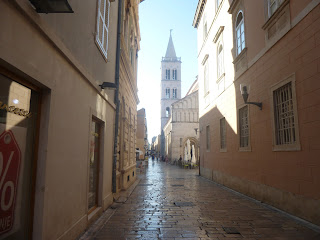During a series
of cruises along the Adriatic coast I was struck by the beauty and booming tourism in towns of former Yugoslavia, previously part of the great Venetian marine
empire in the 12-18th centuries.
 |
| "living room" of Hvar-the main piazza |
 |
| just like Italy..... pizza break in lively Koper |
Each has its unique character, history and structure but they also share lifestyles and traditions similar to those found here, in central Italy. For example, the use of the main piazza as the town’s elegant living room for the afternoon passeggiata.
By studying what our neighbors on the Adriatic are doing -and
have done- in the tourism field, we can discover which mistakes to avoid and which of their best practices to follow. Here are some personal observations and ideas to help increase tourism while protecting the
quality of life for residents and
visitors.
 |
| shiny stone pavements of Zadar |
The tourism industry must protect this quality of life which is one of the area’s main attractions, a quality that the Tuscia Viterbese has in common with these colorful Adriatic ports.
Too much popularity
and tourist hoards can be a strain on
ancient historic centers. Hvar town, a
very popular party destination for young British tourists, has had to
impose rules of conduct and stiff
fines (up to 700 euro) to
control unruly behavior .
 |
| enjoy your stay and obey the rules |
 |
| musician and salt shop, Koper |
The huge crowds of rock concerts are relegated to stadiums outside the delicate
historic centers where amplifiers would be
a danger and unnecessary.
In the port of Zadar even the sea has been harnessed to make music with the recently created sea organ which plays tunes using the lapping waves of the sea .
In the port of Zadar even the sea has been harnessed to make music with the recently created sea organ which plays tunes using the lapping waves of the sea .
 |
| sea organ, Zadar port |
What answers can you give to these questions about your town?
Is the main
public piazza and/or main street still
an elegant public space used for socialization or is it clogged
with cars, speeding motorini or used
primarily for parking?
Are the
ancient, medieval and Renaissance
architectural gems of the historic
center given pride of place?
Are there green areas and
parks close to the historic
center which are well cared for and used by the residents and visitors?
 |
| tower in Zadar similar to those of Viterbo |
 |
| SYA students relax in Valle Faul, Viterbo |
Instead of the Venetian lion seen in all the Adriatic ports, the
area of Tuscia boasts other symbols on palaces and castles: Viterbo’s lion and palm, the heraldic crests that remind us of past Papal domination and the local noble
families -Farnese, Odescalchi, Monaldeschi -who once ruled the area.
The construction materials also differ: our local buildings are
constructed of grey tufa and peperino and we walk on cobblestone streets instead of shiny Istrian stone.
Although less spectacular than the majestic city walls surrounding Dubrovnik and Kotor those of Viterbo, Tarquinia and other local fortified towns have yet to be given the attention they deserve .
Although less spectacular than the majestic city walls surrounding Dubrovnik and Kotor those of Viterbo, Tarquinia and other local fortified towns have yet to be given the attention they deserve .


No comments:
Post a Comment